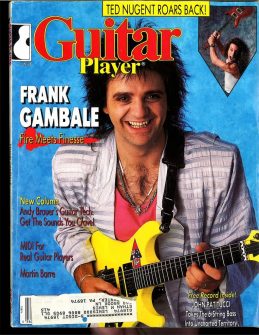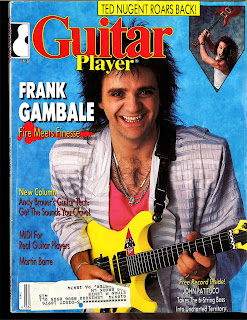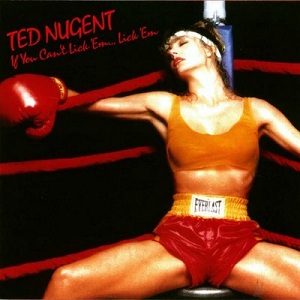2018

My Back Pages: Thirty Years Ago in Guitar Player (June 1988)

June 1988 is when I graduated from high school, and just as that marked a major epoch in my life, there was a lot in the June, 1988 issue of Guitar Player that reminds me very vividly of what I was doing musically at the time. As I’ve mentioned before, I was taking weekly guitar lessons with a recent GIT graduate whose teacher in Hollywood was this month’s cover star, Frank Gambale. Most readers of the magazine might have first heard of The Thunder From Down Under in the previous September’s issue on “Speed And How To Get It“, but I got to listen to Frank at my weekly lessons, and also goggle at my teacher, Jim McCarthy’s amazing sweep picking skills. In fact, I remember bringing this issue to our lesson and Jim greeting me at the door with his own copy and a huge smile on his face.

I was in the right place at the right time. Not only was I carting gear around for guys, supplying my own special pieces at times, but I was offering a personally specialized and knowledgeable service. It started in the backseat of my car, and now I have a great staff of six guys, who all play guitar, busting their butts for our clients. I have over 50 individually selected guitars, over 100 handpicked amps, racks, speakers and so forth, all of which allow me to offer that much more of a personalized service.
For an Eric Clapton session on “Behind The Sun”, I selected a Mitchell Tweed Deluxe amp that Howard Dumble modified for me. In my opinion it was the ultimate blues amp. You play hard, and it’s nasty; you soften up, and it’s sweet. Sure enough, Eric fell in love with it and eventually I was convinced to sell it to him….That’s what I do: I collect magic and rent it.
There is no single best sound. The best sound is whatever makes you the most happy, and one man’s honey can be another man’s poison….The trick is to get the sound coming out of your hands by the way the can manipulate the sound without an amp.
…[t]he Japanese have never gotten it right for pickups. They even use American wire, bobbins and everything, yet they still can’t get them to sound great….You’ve got to find the pickup that works well with your own playing techniques.
The Howard Dumble Overdrive 50 was my ticket to success in the studios. I would be an obnoxious nuisance and bug Steve Lukather, Lee Ritenour, Larry Carlton and Jay Graydon until they would plug into the Dumble. And then I had them, because they needed me to rent this amp that they loved.
By actually seeing what is renting out of my shop, I can see what the trends are. I’d say we are about three years ahead of what is hitting the mainstream now. Just recently, I’ve noticed a drop in rack usage and an increase in Vox and old Marshall rentals….[p]retty soon, guys are going to be getting back to the thing of just plugging in.
******************
“Behind him, a stuffed bear stands frozen beneath a mantel stuck full of knives. Shelves are neatly divided: one for cassettes, one for live ammo. VCRs and amps are scattered among chainsaw, critter skulls, venison sausage and a rocket launcher. For Ted Nugent, music and hunting are serious business. ‘If I weren’t a rock and roller,’ he asserts, ‘I’d probably be a special weapons expert in the Detroit SWAT team, or a commando in an elite anti-terrorist squad.'”
While Ted Nugent was famous for rocking hard on a Gibson Byrdland, a short-scale, fully hollow guitar that few would consider for such loud music, by the time of this piece he had started using a Paul Reed Smith solidbody. Nugent was very enthusiastic about the PRS, and what he said would seem right at home on modern guitar forums.
…[t]he new Paul Rivera stereo tube amplifier and the Paul Reed Smith guitar…is just wonderful, and you have to hear it live to really appreciate it. It is the richest, thickest, creamiest guitar tone you’ve ever heard in your life. I’m telling you, it’s unbelievable.
The appeal of the Paul Reed Smith guitar is touch. I’m a utilitarian, basically, and I’m also a seat-of-the-pants liver. I like to live by function and feel. My cars have to handle precisely, my firearms have to respond flawlessly. There’s a ‘player’s touch’ to Paul Reed Smith’s approach to the instrument that I am convinced is unique in the industry. There’s no other neck that you can consistently pick up like you can a Paul Reed Smith and feel at home with immediately. The body configuration and tone are just the best–that’s all there is to it.
Later in the piece, Nugent mentions that PRS “does something to the Marshall 100-watt head that gives it a full richness”, which is followed by this comment from what the forums call Paul Reed Smith himself:
“New Marshalls don’t sound like old Marshalls, and I modified a bunch of Ted’s tops so that they sound much more like old Marshalls. I’m not going to tell people what I did, because then my business modifying Marshalls would just be gone. I charge $100 per top. Ted has three or four of our straight PRS guitars. His Pearl Black mahogany one has a Hot Vintage pickup in the treble position and our Standard bass pickup. His curly maple guitar has a prototype of the very powerful H.F.S. pickup in the treble position. These pickups were intended to make his guitars a little less shrill and more singing….His guitars use our straight tremolo system which doesn’t need Allen wrenches.”
Jimi and I jammed quite a bit back in the ’60s and we did a couple of dressing room things….You know, thinking back about Jimi, you don’t know what was his personality and what were the manifestations of the drugs that he was doing at the time. That was always the real shame; that’s what really angered me. He was overtly reclusive, and he was real difficult to communicate with. That was one of the reasons I never did any drugs, because I saw this incredible power sadly abused and embarrassingly hampered by all this chemical bullshit. It really pissed me off, because man, could he play! Oh, my God!
If you had seen what he accomplished in one night in New York when I played with him it would have changed your life. It changed mine. The way he played, the notes he chose, the borders he broke down, and th eground that he created, it was absolutely earth-shattering….And Jimi was amazed that I could actually get a Byrdland in control like that, because he tried and was completely lost with it. He couldn’t play it!
So, at this point the only two rock legends I can think of who never did drugs are Ted Nugent and Bruce Springsteen. At least they have something in common.
Finally, as a fan of This Is Spinal Tap, I can’t ignore Ted’s description of the title track to his LP:
“If You Can’t Lick ‘Em…Lick ‘Em”. What do you think of that? Is that the greatest or what? At first the record company was a little reluctant about the title–they thought it was a little too nasty. But it’s not really. It’s just a play on words. It’s like saying, “If you can’t beat ’em, join ’em”. That really is the essence of it. Also, it has to do with the specific combat mode with women. I mean, if you can’t lick ’em, at least you can lick ’em. The whole song was romantically ignited. We’ve always got a lot of miniskirts in the studios….”
Or as Nigel Tufnel once said, “What’s wrong with being sexy?”
**********************
As GP editor Jim Ferguson notes at the beginning of the article, “Of course Frank Gambale has amazing chops, but leaving it at that does him an injustice. Gambale is a top player, and a technical innovator who only uses his facility to execute ideas. In short, he is a remarkable musician.” In his 20’s Frank saved his money to be able to attend the Guitar Institute of Technology, where he was the Student of the Year in 1983 and worked for three years, including 1985-86 when he taught my teacher Jim McCarthy. At the time of this article, Gambale had published two books (Sweep Picking and The Frank Gambale Technique Book) and was working on a video, which you can still find on YouTube:
You seemed to get labeled as a technically oriented player….Were there any drawbacks to having that kind of reputation early in your career?
Not really, but it irritated me a lot. I got lumped in the same old guitar category, where you get evaluated in relation to the guitar and not in terms of what other musicians are doing. It might sound strange, but I’m at the stage where I don’t even want to be categorized as a guitarist; I’d rather be classified as a musician who happens to play the guitar. I’m trying to go beyond the nature of the instrument in terms of the way that I play. My whole style comes from the notes I choose, rather than the physicality of the instrument.
In other words, my technique developed as a result of wanting to play certain notes. When people hear me at a gig, their reaction is usually “How do you play that?” But when Allan Holdsworth opened for the Electrik Band during a tour last year, he said “Man, I really dig the notes you play.” He’s a phenomenal musician, so that was a very high compliment. He didn’t care how the hell I did what he heard because he was listening to the notes. You have to have good ears to discern the difference between content and technique. I don’t play for the guitarists in the audience, I play for the musicians.
You have a rock sound and look about you, but your playing draws from the jazz vocabulary. How do you like to be described?
The term jazz is used very loosely these days, and it doesn’t mean a damn thing. My records include everything from funk to Brazilian stuff to swing to rock ballads. I write whatever I want and I don’t worry about labels…..Music theory is very interesting, and finding new chord changes is important. There’s nothing wrong with a I-IV-V progression, but I couldn’t play it with conviction. Over the years I’ve done a lot of different kinds of music, including rock, country, disco and funk, so that’s where my compositions come from.
A lot of your single-note style is sax-derived. What are the basic differences between a sax player’s approach and that of a guitarist?
The guitar’s fretboard is conducive to things based on positions and shapes, so you find yourself falling into ruts and playing the same ideas over and over. In other words, you see a shape, rather than invent it in your head. Now I’m not a sax player, but I assume that the nature of the instrument doesn’t encourage that so much….The beautiful thing about transcribing saxophone or piano solos is that there’s no pre-conceived way of playing those notes. Since they don’t fall into the usual fretboard patterns, you have to find new ways to find them on the instrument.
What do you suggest for developing a vocabulary that’s more horn-like?
Start listening to saxophonists, obviously. There’s a number of great players; Michael Brecker is probably the kingpin. Few of his solos are very easy, so they’re always a challenge. Playing any of his solos from beginning to end on the guitar is a considerable achievement. Even his slow passages are beautifully played, and the note content is always fresh and exciting.
This really hits home now, and I can remember my teacher urging me to transcribe sax solos. Obviously my limited musical facility made that impossible, but in the past few years I’ve reached the point where I can learn phrases and passages from horn players, and it really does help.
***********************
That’s all for this month. I hope you enjoyed it, and that you’ll come back for next month’s cover story on Jerry Garcia of the Grateful Dead. Until then, keep on picking!
Hits: 334



